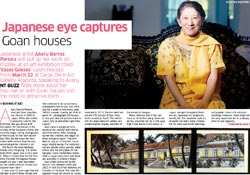
Japanese eye captures Goan houses

Akeru Barros Pereira married Goan Joao Barros Pereira in 1987 in Japan. When she visited Cansaulirn, Goa for the first time, she was struck with fascination for the houses in the vicinity of her husband's home. She instantly began taking photographs of the houses for her own record but, little did she know her fascination with ancient Goan houses would propel her interest in art.
She found the Goan heritage homes very intriguing: "For somebody from Japan, Goa is very exotic. When I visited here for the first time, the Indo-Portuguese houses caught my eye. I was fascinated by the combination of houses and coconut trees here.
It was only 12 years ago that she decided to paint these houses and she continues to do so on every subsequent visit to Goa. She visits Goa for a week or two every year, within a week, I hardly get time to paint. So I photograph the houses in Goa and take the pictures back to Japan. And as and when get time, I paint"
Akeru was a manga (picture- word) writer and did both stories and illustrations. After bringing up her two children, she began to draw and paint again, "I haven't been to any art school but I've always liked drawing. The materials I use are simple colour pencils, water colour, and ink and paper for calligraphy. Every elementary school child in Japan uses them and these are available in ordinary shops.
Akeru had various art exhibitions in Goa between 2006 and 2013. In fact 50 of her sketches are included in the book ‘The Indo-Portuguese House’ by Gerard da Cunha launched in 2013. She has sketched around 170 houses of Goa, from North as well as South The exhibition at Carpe Diem Art Gallery' will predominantly display sketches of the houses in Margao.
Akeru believes that if she can have an exhibition using these materials, anybody can do it. She says that if ore learns in art school in Japan, one gets to explore Western art, Japanese art, sculptures, murals, etc. For Japanese style art, students can learn using Chinese ink for black and white paintings and powder colours for coloured paintings. However, these materials are very expensive for an ordinary artist to use regularly.
Ask her about the houses of Goa and Japan, she says they stand in stark contrast to each other. Unlike concrete houses here, the houses in Japan are made of wood and paper to safeguard inhabitants from earthquakes that occur very often. They Use sliding doors to save space in the house Akeru says that Japanese like to use every corner of the house as they are usually smaller in size. The big temples are however an exception "There are many ordinary houses in Japan, however when we move to the cities, there are several apartment styled buildings," says Akeru.
She is a mathematics teacher in a school in Japan, but she also has to look after her home; thus Akeru says she cannot be a full-time artist "I don't have much time to draw or paint because of my work. And there are so many more beautiful houses in Goa! I however will continue to draw them when I have some time on my hands."
Akeru hopes that the people of Goa would preserve the houses the way they are "I hope the ardent houses in Goa will be preserved, from big mansions to tiny houses. Some of the houses have crumbled down but I have painted them unbroken. It is sad that some pretty houses have disappeared after sketched them. When I see old houses I feel the emotions of the people who built them and the people who lived in them. Great Goan masons and carpenters built them houses in an Indo-Portuguese style also feel the joy and tears. That is what try to capture in my drawings and paintings."





